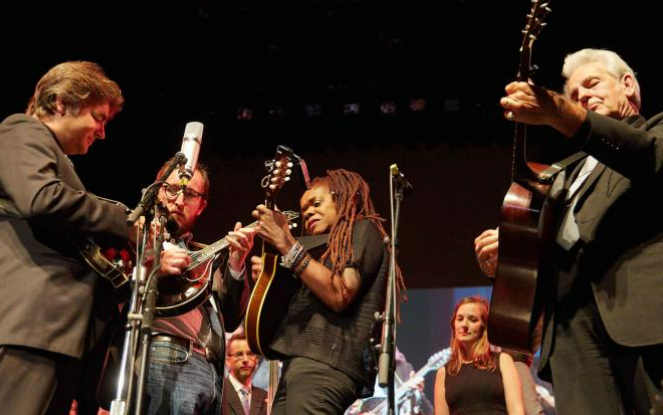In the vast spectrum of American entertainment, music stands out as a universal language that resonates across diverse communities and lifestyles. From the soulful tunes of the blues to the energetic beats of hip-hop, it has been a constant companion, reflecting and shaping the cultural landscape of the nation. In this exploration, we delve into the multifaceted role of music as entertainment in America, understanding how it has become an integral part of the American experience.

The Melodic Tapestry of Diversity
To begin with, one of the remarkable aspects of singing in America is its incredible diversity. Rooted in a rich history that includes influences from African rhythms, European classical traditions, Native American melodies, and more, American music is a harmonious blend of cultural threads. Jazz, often considered America’s classical songs, emerged in the early 20th century, fusing African and European musical elements to create a genre that epitomizes the melting pot of cultures. Over the decades, this diversity has only expanded, giving rise to genres such as rock, country, R&B, pop, and electronic dance songs. Each genre carries its unique characteristics, reflecting the experiences and stories of the communities that embrace it. This rich tapestry of musical genres serves as a testament to the cultural mosaic that is America.
The Power of Music in Social Movements
Additionally, songs have played a pivotal role in shaping and expressing the sentiments of social movements throughout American history. From the protest songs of the civil rights era to the anthems of anti-war movements, music has provided a voice for the marginalized and a rallying cry for change. Artists like Bob Dylan, Nina Simone, and Woody Guthrie became synonymous with activism through their powerful lyrics and melodies, amplifying the voices of those advocating for justice and equality. In recent years, the intersection of music and social movements has continued to thrive. Artists like Beyoncé, Kendrick Lamar, and Lady Gaga use their platforms to address issues ranging from racial injustice to LGBTQ+ rights. The ability of music to inspire, unite, and challenge societal norms remains a potent force in contemporary America.
Live Music Experiences
Furthermore, one cannot discuss music as entertainment in America without acknowledging the transformative power of live performances. Concerts and music festivals are not merely events; they are communal celebrations where fans come together to share a collective experience. The pulsating energy of a live performance, the roar of the crowd, and the connection between artist and audience create moments that linger in the memories of attendees.
Iconic venues like the Apollo Theater in Harlem, the Grand Ole Opry in Nashville, and the Fillmore in San Francisco have become cultural landmarks, hosting legendary performances that have become part of the nation’s musical legacy. Whether it’s the electric atmosphere of a rock concert or the soulful intimacy of a jazz club, live music experiences contribute to the fabric of American entertainment.
Technology’s Influence
Additionally, the evolution of music consumption has been shaped by technological advancements. In the mid-20th century, vinyl records became a cherished format, allowing listeners to experience the warmth and authenticity of analog sound. The advent of cassette tapes, CDs, and digital downloads further transformed the industry, providing new avenues for artists to reach audiences. In the digital age, streaming services like Spotify, Apple Music, and Pandora have revolutionized the way people discover and enjoy songs. Also, the convenience of on-demand access to an extensive library of songs has democratized the music landscape, enabling artists from diverse backgrounds to find global audiences without the traditional gatekeepers.
Music as a Lifestyle
Moreover, beyond the auditory experience, music has permeated American culture, influencing fashion, language, and lifestyle. Iconic music festivals like Woodstock in the ’60s and Coachella in the present day serve as not only showcases for musical talent but also as cultural phenomena where fashion trends are born and artistic expression is celebrated. Genres often become synonymous with certain subcultures, influencing everything from fashion choices to slang. Hip-hop, for example, has not only left an indelible mark on the music industry but has also shaped urban fashion, language, and attitudes. Additionally, the symbiotic relationship between music and culture continues to evolve, reflecting the ever-changing dynamics of American society.
Conclusion
In understanding music as entertainment in America, we embark on a harmonious journey through the diverse sounds, cultures, and stories that shape the nation. From its roots in centuries-old traditions to the digital age of streaming and global connectivity, music remains a dynamic force that transcends boundaries. As we immerse ourselves in the melodies that echo through time, it becomes clear that music in America is more than just entertainment; it is a reflection of the nation’s spirit, resilience, and endless capacity for creativity. Whether experienced through the crackling warmth of a vinyl record or the seamless flow of a curated playlist, music continues to be a vital and enduring part of the American experience. It is a harmonious thread that weaves through the cultural tapestry, connecting hearts and souls across the vast landscape of the United States.











